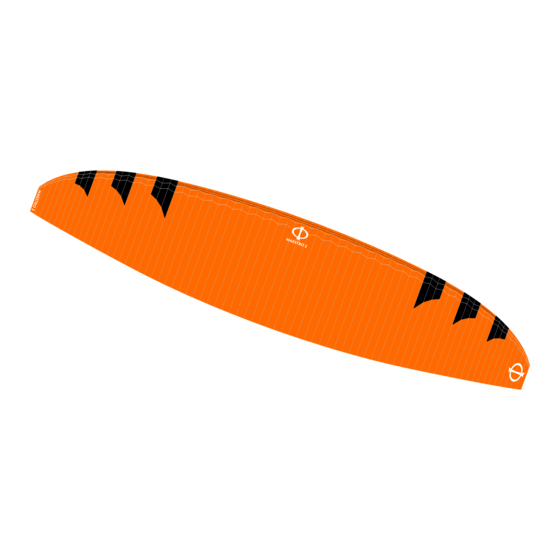
Table of Contents
Advertisement
Quick Links
Advertisement
Table of Contents

Summary of Contents for PHI MAESTRO 2
- Page 1 Manual Version 1.02 vom 19.09.2022...
- Page 2 Technical description The MAESTRO 2 has 78 cells across the entire span, of which 9 cells each on the Stabilo are designed as closed cells. This creates a very form stable and homogeneous wing. The profiles used combine high performance with a very forgiving flight behavior.
-
Page 3: Pilot Requirements
(and other equipment). If the MAESTRO 2 is flown in the lower half of the legal weight range, reduced agility can be expected. In strong turbulences a lower stability may be noticeable. The reaction on extreme maneuvers is very relaxed. - Page 4 Flying turns A turn is an interaction of inner brake, outer brake and weight shi ing. The art is the right dosage. The MAESTRO 2 is characterized by a sensitive handling. Small brake inputs are enough to fly precise turns.
-
Page 5: Rapid Descents
Landing The MAESTRO 2 is easy to land. In the final approach against the wind flare the wing at an appropriate height. Normally about 1m above ground level, the angle of attack should be increased by more and more braking. When the minimum speed is reached, the brakes are pulled to the max, the wing and this technique allows a so touch down. -
Page 6: Asymmetric Collapse
50% of the span affected, the glider shows a more dynamic reaction: Due to the increased drag of the folded wing, the MAESTRO 2 will start to turn to the side of the collapse. At the same time, the glider pitches forward as a result of the smaller loaded wing surface and therefore higher wing load and needed airspeed. -
Page 7: Frontal Collapse
- one side is slowed down too much in slow flight (for example during thermal flying) If an accidentally initiated negative turn is corrected immediately, the MAESTRO 2 goes into normal flight without any major loss of altitude. The brake that has been pulled too far should be released until the airflow on the inner wing attaches again. -
Page 8: Winch Launch
A er a big collapse or a er a badly executed full stall, a part of the wing might be tangled up in the lines, and wonʼt reopen automatically. This is what you call a cravate. During our extensive test flights with the MAESTRO 2 we never experienced a cravate but this situation can not be eliminated for any paraglider. - Page 9 In flight, the MAESTRO 2 can now be accelerated by pushing the speed bar, which results in a reduction of the angle of attack and as a consequence an increase of airspeed. The speed increase compared to trim speed is about 15 - 17km/h.
-
Page 10: Service And Maintenance
Exceptions are the replacement of lines as well as the repair of small tears (up to 5 cm, which do not affect seams) or holes in the cloth, which can be repaired with the original PHI repair set. A small set of sticking cloth is supplied with the wing. -
Page 11: Registration, Warranty
Especially in the cold season, this stress can be life-threatening for animals. Disposal The plastic materials used in a paraglider require proper disposal. Please return your used wing to PHI: it will be disassembled and disposed of by us. PHI, eine Marke der Papesh GmbH... -
Page 12: Technical Data
Technical Data MAESTRO 2 size number of cells projected span 8,81 9.26 9,49 9,69 10,10 projected area m² 18.82 20.81 21.81 22.77 24,72 projected aspect ratio 4.13 4.13 4.13 4.13 4.13 flat span 11,02 11.59 11,87 12,12 12,63 flat area m²... -
Page 13: Overview Risers
Overview risers... - Page 14 R07 riser...
- Page 15 Overview wing...
- Page 16 Leineplan...


Need help?
Do you have a question about the MAESTRO 2 and is the answer not in the manual?
Questions and answers